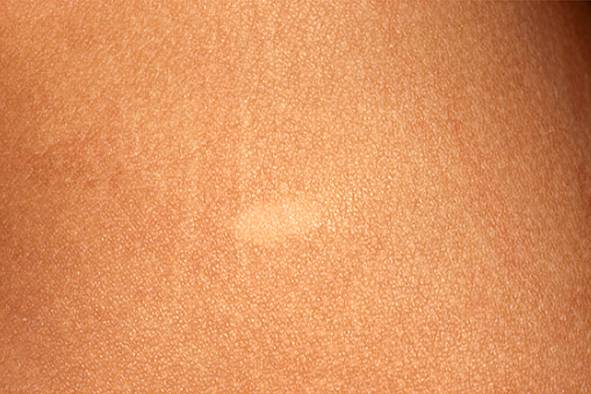Tuberous Sclerosis Complex (TSC)
What is TSC?
TSC is a genetic disorder that can affect multiple organs including the skin, brain, kidneys, heart and lungs. The incidence is reported to be between 1 in 5800 and 1 in 10000.
What causes TSC?
TSC is caused by a mutation in either the TSC1 gene on chromosome 9 or the TSC2 gene on chromosome 16. It is inherited as an autosomal dominant trait which means that the child of an affected parent has a 50% chance of inheriting the condition. About two thirds of cases are new mutations but the parents of an affected child must be closely examined as it is possible to have the condition very mildly.
What is the first sign of TSC?
White patches on the skin of 1-3cm, called ash leaf or hypomelanotic macules, are the first sign and are present at birth or appear in early infancy (Figure1). Many people have one or two white patches as harmless birthmarks but the presence of three or more increases the likelihood of the condition. Seizures starting in infancy are the next most common sign.

What are other skin signs?
Facial angiofibromas are small, red spots that start to appear on the cheeks, nose and chin between two and five years of age. They are initially flat but become more raised over time (Figure 2).

Forehead fibromatous plaque is a slightly yellowish to skin coloured raised area on the forehead or scalp, present in about 20% of affected individuals.
Shagreen patch is a raised, orange peel like area of skin, usually present over the lower back. It is rarely seen in infancy but increases in size and number with age, eventually affecting just under 50% of affected individuals.
Periungual fibromas (Koenen’s tumours) are skin coloured or reddish growths around the nails, developing in later childhood and adult life.
What other organs are affected?
A range of growths develop in the brain with 90-96% of affected individuals developing epileptic seizures. The seizures start in the first two years of life in 85% of cases.
Autism and impaired intellectual ability occur in 40-50% of affected individuals, more commonly in those who have had frequent seizures from an early age.
The kidneys develop lumps called angiomyolipomas in up to 80% of cases. Cysts can also develop.
The heart can have a growth called rhabdmyoma in 47-60% of affected individuals. These mostly reduce in size with age.
The lungs can be affected, particularly in young and middle aged women, by a condition called lymphangioleiomyomatosis.
Other changes include dental enamel pitting, growths on the gums (gingival fibromas) and white streaks on the back of the eye (retinal hamartomas).
How is TSC diagnosed?
The diagnosis is made on clinical grounds, using major and minor diagnostic criteria. Molecular genetic testing is also available but is only able to find the mutation in 75-80% of cases. A negative genetic test does not exclude the condition.
How is TSC treated?
Seizures are treated with anti-seizure medication and occasionally surgery. Medications called mTOR inhibitors are used for some of the brain and kidney growths and to treat lung complications. These medications can be used in a topical (cream) form to prevent the facial angiofibromas enlarging and bleeding.
Further information
Tuberous Sclerosis Facebook page
This information has been written by Dr Anne Halbert